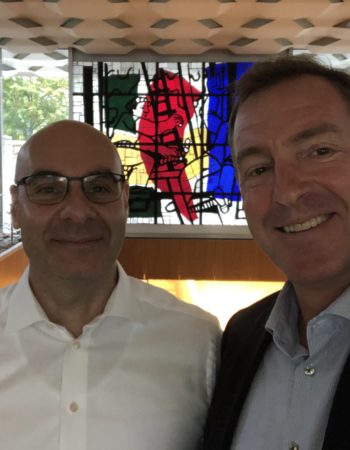
In January 2020, 12 global pharmaceutical companies and 17 public and private entities; including technical, legal, regulatory, academia, research organisations and patient representative organisations, got together to form PharmaLedger, the pharmaceutical blockchain consortium.
Joining us for this podcast is Daniel Fritz, PharmaLedger Industry Project Leader and Supply Chain Domain Architect at Novartis and Marco Cuomo, Manager Applied Technology Innovation at Novartis, a team that brings in new technologies, such as blockchain, into Novartis. Marco is also the co-lead architect at PharmaLedger for the blockchain platform.
What is blockchain?
Daniel likes to introduce blockchain with the five A’s:
- Assets, too often blockchain is associated with cryptocurrencies as assets but assets can also be data and medicinal products that can be exchanged on a distributed ledger technology
- Audit, the immutability aspect of blockchain is good for audit.
- Automation, use of smart contracts eliminate non-value adding steps
- Anonymize, especially important in the healthcare care industry to protect the patient’s data by keeping it confidential and protecting their privacy
- Authority, no central authority where authority is distributed amongst the participants
For Marco the real strong added value blockchain provide at its core is the immutability function. Whatever you store on the blockchain, transactions and data are immutable so no one can change it.
An introduction to PharmaLedger
PharmaLedger, launched in January 2020 as a public private partnership under (IMI) the Innovative Medicines Initiative, a joint undertaking between the European Union and the (EFPIA) European Federation of Pharmaceutical Industries and Associations. It’s a three project with over €22m of public private funding. There are 29 partners in the consortium which includes 12 pharmaceutical companies whose goal is to accelerate blockchain adoption. Its aim is to prove that this technology can bring value to patients, increase trust amongst all of the different ecosystem stakeholders and enable new capabilities around supply chain clinical trial and health data. In addition it aims to demonstrate that blockchain can address some of the key challenges the industry has around identity and governance.
The whole idea of the IMI is actually about building consortiums to address problems or challenges that are too risk for any one company or too expensive for any one company and which would benefit from having public partnerships.
PharmaLedger use cases
PharmaLedger has launched with 8 use cases broken down into three domains:
- Clinical trials
- Health data
- Supply chain
Within the supply chain domain, you have two versions of supply chain traceability: clinical supply and finished good traceability. There is electronic project information (ePi) which is also known as an e-leaflet, or an e-patient information leaflet. It’s a digital version of the leaflet you find in a medicine box. It contains the latest approved version of that leaflet in a manner that preserves the patient’s privacy. In the future it will have the capability to send out recall notification, if there was a quality issue of that product, to send updated product information and also to apply some additional checks on the provenance of that medicine to help reduce the risk of counterfeits.
On the clinical trial side, they have eRecruitment which is clinical trial recruitment so that patients can share their health profile and be matched through an algorithm to open clinical trials. Clinical trial eConsent aims to reduce the very administrative process for agreeing to undergo procedures and processes for any clinical trials. Clinical trial for IoT devices is for getting data from devices. Personalised medicines is putting it all together with some advanced digital technologies like machine learning and artificial intelligence to help predict what kind of diagnosis or treatment the patient should have in the future.
Competitors collaborating together
For Marco the real transformational aspect of using blockchain is that the entire industry is working together in building digital ecosystems to benefit together from this technology. Building this digital ecosystem means the members have to work and collaborate together to define standards.
All technologies that is developed in the PharmaLedger consortium is open sourced. So, whoever within the consortium develops some code it is open sourced for all other members to use and to build upon.
Governance
Daniel looks at governance from a project governance standpoint and from what he calls a next generation governance structure. From a project governance perspective, they have a steering committee, a project management board and a general assembly for all 29 partners. Any major changes to the membership of the consortium requires unanimous approval of all 29 partners.
The next generation governance structure is here to provide a governance body to manage a blockchain network and ecosystem which should be decentralised but with some kind of control or guidance. The present thinking is to have a foundation ecosystem which is to oversee the blockchain network and how application decisions are done. They will test out this new governance body for the electronic product information. Marco anticipates that there probably won’t be one governance model for all use cases but different ones that fits best each use case. There are ongoing discussions on how best to achieve this.
The PharmaLedger blockchain platform
The PharmaLedger project’s main goal is to establish an ecosystem where everyone can use a blockchain platform without the need to reinvent every time they have an idea to utilise blockchain. However, at the same time Marco points out that they didn’t want one big fat blockchain network but something that is more flexible. They wanted a platform that could grow with time and that had the capability to replace, expand or adopt new technologies.
All use cases don’t all have the same requirements. They don’t all need payments or voting features and some may only need anchoring services.
To achieve this need of flexibility they developed an abstraction layer, called open DSU (dat sharing unit) that separates the blockchain applications from the blockchain and to have the capability to define blockchain networks and blockchain technology for each individual use cases. For example, a use case could choose to have a public, private or hybrid blockchain network.
Due to GDPR and capability issues data isn’t stored on the blockchain. The Open DSU, the abstraction layer, solve the interoperability issues between the different blockchains, applications and where the data ultimately resides. The abstraction layer also handles the questions around private keys and thus helps the application developers to focus on the business solution and not on the underlying technology.
From an identity standpoint the open DSU layer supports different identity systems and issuers. It ensures that the users and the organisations are in control of their identity and of their data and the application who is working with that data is also under their control.
Impact of COVID
COVID has demonstrated the importance of getting reliable information on a product, especially with regards to vaccines. The electronic product information helps to address that. There has been many instances of counterfeited personal protective equipment which can be addressed with ability to track the provenance of the materials.
The IoT use case for clinical trials helps to perform clinical trials without having to come to the hospital through the use of remote devices.
What COVID has provided is the opportunity for what Daniel calls as hyper collaboration where manufacturers joining forces to help fill demand.
Post 2022
The grant agreement with the IMI and EFPIA, which comes to its conclusion at the end of 2022, is to demonstrate the uses cases in a pre-production environment, to document it, to disseminate the information through research papers, conferences, hackathons, and webinars.
For Daniel, a real achievement would be to have one of these use cases in a productive state before the project ends and to have the functional governance set up an operational.
For Marco, the three years of PharmaLedger is really to lay down the foundation that will give birth to many new use cases.







